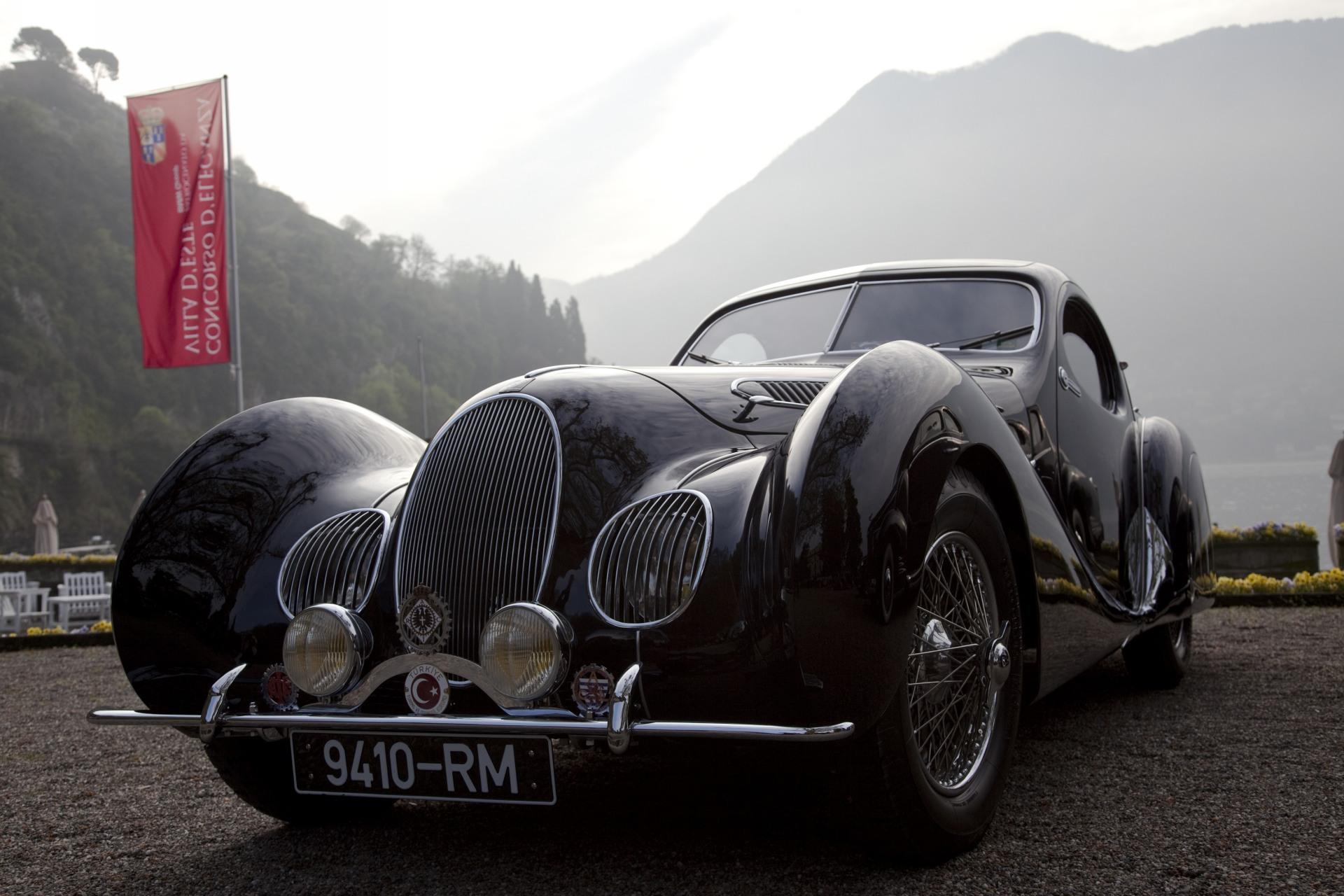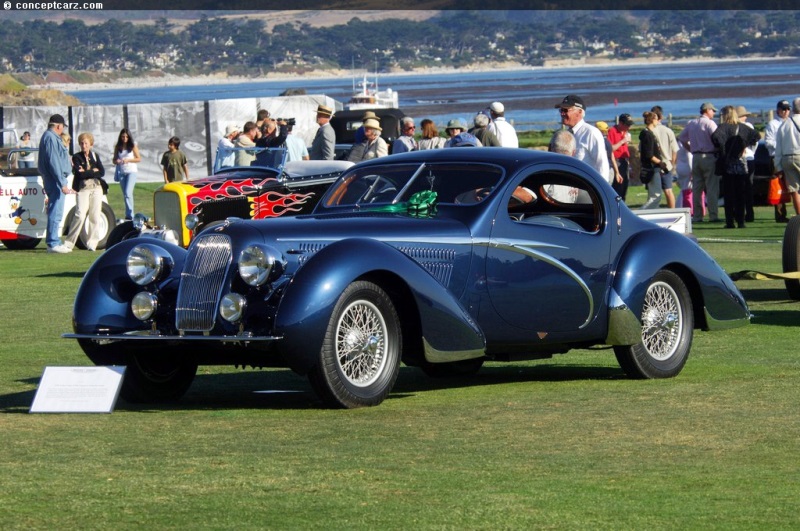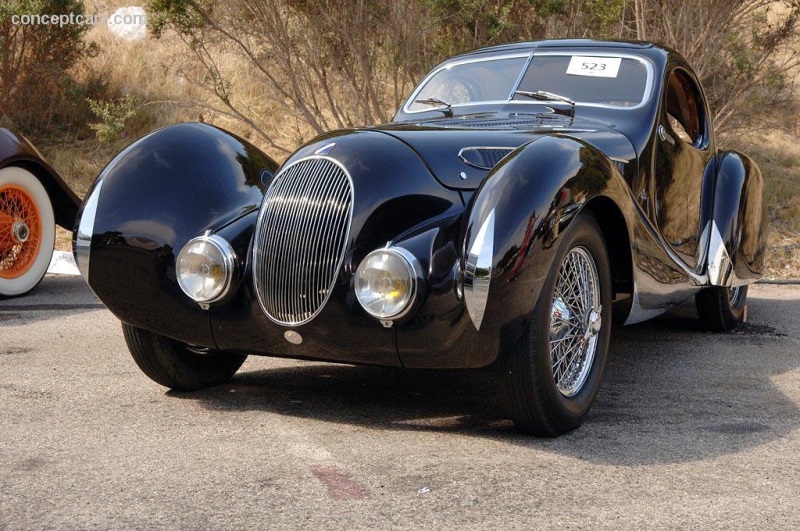The Great Depression of the 1930s had a devastating effect on many businesses, and for the French Talbot factory in Suresnes outside Paris, crippled their financial prospects. Among the reasons for its demise, were the haphazard technological developments, outdated styles, and a dizzying array of models. Depleted of liquidity by the end of 1933. The banks closed the company credit line and the managing director Owen Clegg cabled Sunbeam-Talbot in London that Talbot in France was facing closure and liquidation. An individual named Anthony Lago was sent to France in a last-ditch effort to save the ailing company. Miraculously, he succeeded. Superfluous model variations were dropped, engines and drivetrains were improved, the entire Talbot line was revamped, and the Wilson pre-selector gearbox - for which he held the patents - was introduced to the line.
Anthony Lago was an Italian-trained engineer and, after serving in the Italian Army, where he rose to the rank of major during World War I, began his automotive career selling Isotta-Fraschinis in London. Up to that time, the Isotta-Fraschini was the finest Italian car ever produced, with world-class craftsmanship, style, and engineering. This quality and attention to detail made a lasting impression on Lago and would be a hallmark of his career. Major Lago later worked in a series of automotive engineering apprenticeships throughout London, including Sunbeam. While working at Wilson, he assisted in the final development of the preselector gearbox, later leading to the acquisition of foreign distribution rights to the Wilson gearbox. Along with using it in his own cars, other firms such as Daimler, Alvis, Crossley, Lanchester, MG, Invicta, Standard, Armstrong-Siddeley, Isotta-Fraschini, and Talbot were using Wilson gearboxes.
With a passion and fascination for motorsports, Anthony Lago accepted a position on the Armstrong-Siddeley works team in 1932 and competed at that year's Alpine Trials. Later in the year, he joined the ailing Sunbeam-Talbot-Darracq firm. From there, he was sent to France, and soon the Rootes company acquired the English side of Sunbeam-Talbot-Darracq, and Lago, who had acquired considerable financial support, assumed control of the French Talbot concern.
An engineer named Walter Brecchia was hired by Lago, and together they created the first Talbot-Lago based on a Talbot-Darracq three-liter Type K78. From there, using the seven-main bearing six-cylinder K78 block, displacement was increased to four liters, and a new cylinder head was added to improve volumetric efficiency and breathing. The hemispherical head design had valve gears actuated by a low-set camshaft with crossed pushrods acting through both long and short rocker arms. With the help of twin Solex carburetors, the new six-cylinder unit developed 140 horsepower at 4,200 RPM.
With solid engineering footing, Lago was able to persuade French racing great René Dreyfus to manage his new Talbot-Lago race team, resulting in all three Talbot-Lagos finishing in the top ten at the 1936 French Grand Prix at Montlhéry, even contesting the Bugattis for top positions before mechanical problems forced the slow near the end.
The following year, at the French Grand Prix, Talbot-Lagos placed first, second, third, and fifth. Additional victories followed, including at Tourist Trophy races at Donnington Park and a first place in the 1938 Monte Carlo Rally. They scored many class victories against much more powerful opponents, relying on durability and fuel economy, and proving the old racing adage 'to finish first, first you must finish'.
Along with racing successes, the Talbot-Lago quickly gained a reputation as one of the finest French cars of all time. The reliable new engine provided the basis for a new chassis, and the racing accomplishments provided the perfect image to lure wealthy and powerful new clients. Style was paramount, so Anthony turned to Joseph Figoni to help create new designs for the entire line of Talbot cars. At the Paris Salon in October of 1934, a coach-built cabriolet by Figoni, wearing a Figoni plaque, was displayed on the Talbot stand. It later served as a design template for the forthcoming Talbots that were built at the company's proprietary in-house coachbuilding facility at the Suresnes factory. The new model was called T150 C or Lago Spéciale.
The new T150 used a dual braking system, a larger capacity oil pan, an advanced suspension geometry, and a higher compression version of the engine. The first version was designed 'SS,' as in the English phrase 'Super Sport', and rode on a short-wheelbase 2.65 m chassis that was suitable for two- or three-place coachwork. The Lago Spéciale was mechanically identical to the SS, powered by the 4.0-liter six delivering 140 horsepower in standard street guise, and intended to accommodate more luxurious bodywork with its 30 cm larger (11.8 inches) chassis.
The Talbot-Lago was the ideal chassis for the charismatic Figoni & Falaschi teardrop style. Talbot revised the original Figoni designs in 1938, reworking the beltline and sides and adding a chrome strip. The terms used to describe the bodies were teardrop, aerodynamic, graceful, sweeping lines, and simply stunning. The disappearing convertible top mechanism was re-engineered to a non-disappearing configuration for increased luggage space. The T150C could now be ordered with an optional, aerodynamic, and patented Figoni grille design in place of the traditional Talbot factory grille.
During its production lifespan, approximately 51 examples of the T150C models were built, including the SS version. 17 Talbot Lagos chassis received the Teardrop body, including three T23 chassis. The Teardrop came in two styles, with one being a notchback coupe named 'Jeancart' after the commissioner of the first car, and the second style was the 'New York' style. Five examples of Jeancart-style cars were built. Whether in the 'Jeancart' or 'New York' style, all these hand-built cars show minor differences based on the original owner's requirements. Most Teardrops were designed to accommodate two people, but a few cars could accommodate three. Approximately 10 wore the Style 9220 Model New York built on the short T150-C SS chassis, plus an additional car built on the T23 Baby chassis. The 'New York' style was named after the car shown at the New York Auto Salon in 1937, and two examples had fully skirted front fenders. Approximately 3 T150C examples wore Pourtout coachwork often to designs created by Georges Paulin.
by Daniel Vaughan | Jul 2010
Anthony Lago was an Italian-trained engineer and, after serving in the Italian Army, where he rose to the rank of major during World War I, began his automotive career selling Isotta-Fraschinis in London. Up to that time, the Isotta-Fraschini was the finest Italian car ever produced, with world-class craftsmanship, style, and engineering. This quality and attention to detail made a lasting impression on Lago and would be a hallmark of his career. Major Lago later worked in a series of automotive engineering apprenticeships throughout London, including Sunbeam. While working at Wilson, he assisted in the final development of the preselector gearbox, later leading to the acquisition of foreign distribution rights to the Wilson gearbox. Along with using it in his own cars, other firms such as Daimler, Alvis, Crossley, Lanchester, MG, Invicta, Standard, Armstrong-Siddeley, Isotta-Fraschini, and Talbot were using Wilson gearboxes.
With a passion and fascination for motorsports, Anthony Lago accepted a position on the Armstrong-Siddeley works team in 1932 and competed at that year's Alpine Trials. Later in the year, he joined the ailing Sunbeam-Talbot-Darracq firm. From there, he was sent to France, and soon the Rootes company acquired the English side of Sunbeam-Talbot-Darracq, and Lago, who had acquired considerable financial support, assumed control of the French Talbot concern.
An engineer named Walter Brecchia was hired by Lago, and together they created the first Talbot-Lago based on a Talbot-Darracq three-liter Type K78. From there, using the seven-main bearing six-cylinder K78 block, displacement was increased to four liters, and a new cylinder head was added to improve volumetric efficiency and breathing. The hemispherical head design had valve gears actuated by a low-set camshaft with crossed pushrods acting through both long and short rocker arms. With the help of twin Solex carburetors, the new six-cylinder unit developed 140 horsepower at 4,200 RPM.
With solid engineering footing, Lago was able to persuade French racing great René Dreyfus to manage his new Talbot-Lago race team, resulting in all three Talbot-Lagos finishing in the top ten at the 1936 French Grand Prix at Montlhéry, even contesting the Bugattis for top positions before mechanical problems forced the slow near the end.
The following year, at the French Grand Prix, Talbot-Lagos placed first, second, third, and fifth. Additional victories followed, including at Tourist Trophy races at Donnington Park and a first place in the 1938 Monte Carlo Rally. They scored many class victories against much more powerful opponents, relying on durability and fuel economy, and proving the old racing adage 'to finish first, first you must finish'.
Along with racing successes, the Talbot-Lago quickly gained a reputation as one of the finest French cars of all time. The reliable new engine provided the basis for a new chassis, and the racing accomplishments provided the perfect image to lure wealthy and powerful new clients. Style was paramount, so Anthony turned to Joseph Figoni to help create new designs for the entire line of Talbot cars. At the Paris Salon in October of 1934, a coach-built cabriolet by Figoni, wearing a Figoni plaque, was displayed on the Talbot stand. It later served as a design template for the forthcoming Talbots that were built at the company's proprietary in-house coachbuilding facility at the Suresnes factory. The new model was called T150 C or Lago Spéciale.
The new T150 used a dual braking system, a larger capacity oil pan, an advanced suspension geometry, and a higher compression version of the engine. The first version was designed 'SS,' as in the English phrase 'Super Sport', and rode on a short-wheelbase 2.65 m chassis that was suitable for two- or three-place coachwork. The Lago Spéciale was mechanically identical to the SS, powered by the 4.0-liter six delivering 140 horsepower in standard street guise, and intended to accommodate more luxurious bodywork with its 30 cm larger (11.8 inches) chassis.
The Talbot-Lago was the ideal chassis for the charismatic Figoni & Falaschi teardrop style. Talbot revised the original Figoni designs in 1938, reworking the beltline and sides and adding a chrome strip. The terms used to describe the bodies were teardrop, aerodynamic, graceful, sweeping lines, and simply stunning. The disappearing convertible top mechanism was re-engineered to a non-disappearing configuration for increased luggage space. The T150C could now be ordered with an optional, aerodynamic, and patented Figoni grille design in place of the traditional Talbot factory grille.
During its production lifespan, approximately 51 examples of the T150C models were built, including the SS version. 17 Talbot Lagos chassis received the Teardrop body, including three T23 chassis. The Teardrop came in two styles, with one being a notchback coupe named 'Jeancart' after the commissioner of the first car, and the second style was the 'New York' style. Five examples of Jeancart-style cars were built. Whether in the 'Jeancart' or 'New York' style, all these hand-built cars show minor differences based on the original owner's requirements. Most Teardrops were designed to accommodate two people, but a few cars could accommodate three. Approximately 10 wore the Style 9220 Model New York built on the short T150-C SS chassis, plus an additional car built on the T23 Baby chassis. The 'New York' style was named after the car shown at the New York Auto Salon in 1937, and two examples had fully skirted front fenders. Approximately 3 T150C examples wore Pourtout coachwork often to designs created by Georges Paulin.
by Daniel Vaughan | Jul 2010
Related Reading : Talbot-Lago T150 History
Anthony Lago had taken over control of the Talbot factory in Suresnes after the merger with Sunbeam and Darracq had collapsed in 1936. By 1937 he had introduced a new line of vehicles, two of which were entered in the grueling 24 Hours of Le Mans. He continued his racing endeavors by moving to single-seat racers and by 1939 a purpose-built Grand Prix car had been completed. The onset of World War....
Continue Reading >>
Continue Reading >>
1938 Talbot-Lago T150C Vehicle Profiles
Recent Vehicle Additions
Performance and Specification Comparison
T150C SS Specification Comparison by Year
Year
Production
Wheelbase
Engine
Prices
Related Automotive News

Second Annual Greenbrier Concours
The second annual Greenbrier Concours dElegance was held at Americas Resort, The Greenbrier, which has a long connection with the automotive industry. The Friday leading up to the Sunday Concours included two driving tours - The Summit Drive and the...

A Comparison of 1997 Best of Show and 2022 Best of Show Nominee at the Pebble Beach Concours d'Elegance
Left 1997 Best of Show Right 2022 Best of Show Nominee
The combined efforts of Talbot-Lago and Figoni %26 Falaschi resulted in many wondrous automotive creations, including the T150C model with goutte deau, literally a drop...

1932 Duesenberg J Figoni Sports Torpedo Named Best of Show at the 71st Pebble Beach Concours d'Elegance
2022 Charitable Donations Surpass %242.67 Million
A unique Duesenberg reprised its early role as Concours winner by taking the top prize at the Pebble Beach Concours dElegance.
This year, 40 classic cars from 18 countries and 33 states pulled...

Past Best of Show Winners at The Pebble Beach Concours d'Elegance
overview1
The 70th anniversary of the Pebble Beach Concours dElegance was celebrated with a spectacular display of previous Best of Show winners. Thirty-seven examples graced the showfield and many were still with the same owners who raised the trophy...

Second Annual Greenbrier Concours
The second annual Greenbrier Concours dElegance was held at Americas Resort, The Greenbrier, which has a long connection with the automotive industry. The Friday leading up to the Sunday Concours included two driving tours - The Summit Drive and the...

Concours d'Elegance of America : Best of Show
image0
The 38th Concours dElegance of America displayed over 300 of the worlds most spectacular contributions to automotive history. This year, the event paid tribute to many special features inclduing Ford GT-40s, Body by Dietrich, Rally Cars,...










































